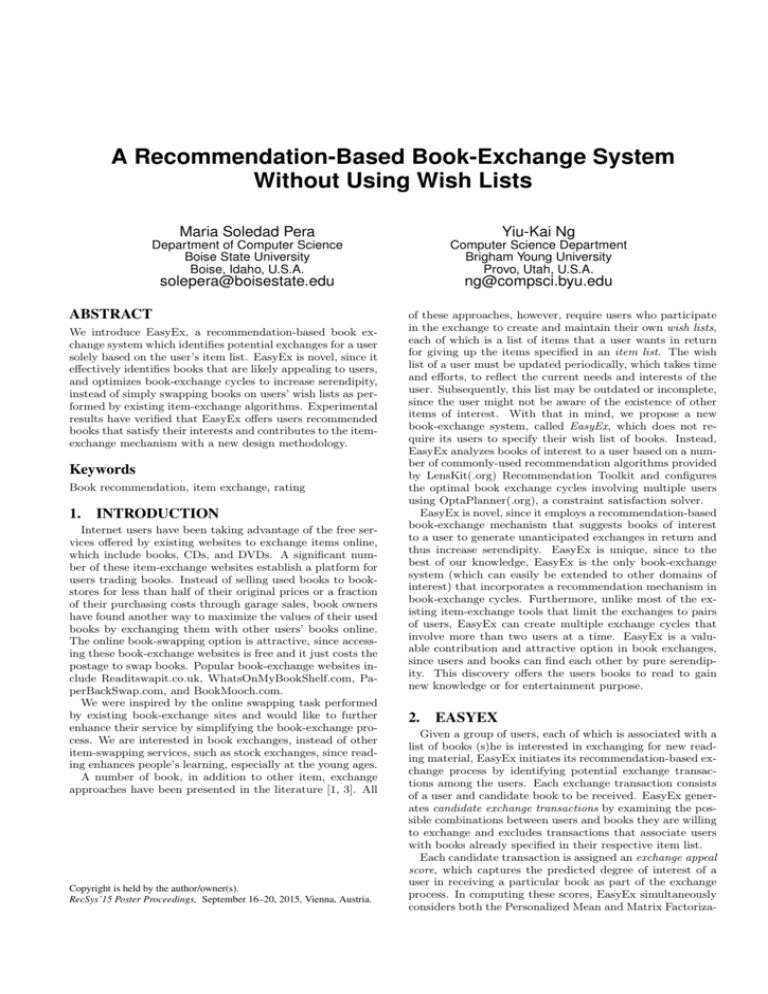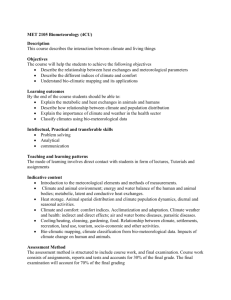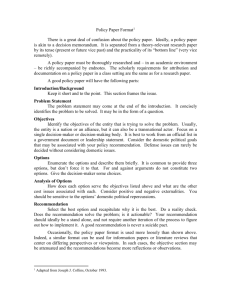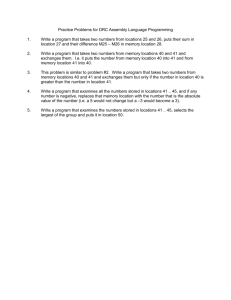A Recommendation-Based Book-Exchange System - CEUR
advertisement

A Recommendation-Based Book-Exchange System Without Using Wish Lists Maria Soledad Pera Yiu-Kai Ng Department of Computer Science Boise State University Boise, Idaho, U.S.A. Computer Science Department Brigham Young University Provo, Utah, U.S.A. solepera@boisestate.edu ABSTRACT We introduce EasyEx, a recommendation-based book exchange system which identifies potential exchanges for a user solely based on the user’s item list. EasyEx is novel, since it effectively identifies books that are likely appealing to users, and optimizes book-exchange cycles to increase serendipity, instead of simply swapping books on users’ wish lists as performed by existing item-exchange algorithms. Experimental results have verified that EasyEx offers users recommended books that satisfy their interests and contributes to the itemexchange mechanism with a new design methodology. Keywords Book recommendation, item exchange, rating 1. INTRODUCTION Internet users have been taking advantage of the free services offered by existing websites to exchange items online, which include books, CDs, and DVDs. A significant number of these item-exchange websites establish a platform for users trading books. Instead of selling used books to bookstores for less than half of their original prices or a fraction of their purchasing costs through garage sales, book owners have found another way to maximize the values of their used books by exchanging them with other users’ books online. The online book-swapping option is attractive, since accessing these book-exchange websites is free and it just costs the postage to swap books. Popular book-exchange websites include Readitswapit.co.uk, WhatsOnMyBookShelf.com, PaperBackSwap.com, and BookMooch.com. We were inspired by the online swapping task performed by existing book-exchange sites and would like to further enhance their service by simplifying the book-exchange process. We are interested in book exchanges, instead of other item-swapping services, such as stock exchanges, since reading enhances people’s learning, especially at the young ages. A number of book, in addition to other item, exchange approaches have been presented in the literature [1, 3]. All Copyright is held by the author/owner(s). RecSys’15 Poster Proceedings, September 16–20, 2015, Vienna, Austria. Copyright 20XX ACM X-XXXXX-XX-X/XX/XX ...$10.00. ng@compsci.byu.edu of these approaches, however, require users who participate in the exchange to create and maintain their own wish lists, each of which is a list of items that a user wants in return for giving up the items specified in an item list. The wish list of a user must be updated periodically, which takes time and efforts, to reflect the current needs and interests of the user. Subsequently, this list may be outdated or incomplete, since the user might not be aware of the existence of other items of interest. With that in mind, we propose a new book-exchange system, called EasyEx, which does not require its users to specify their wish list of books. Instead, EasyEx analyzes books of interest to a user based on a number of commonly-used recommendation algorithms provided by LensKit(.org) Recommendation Toolkit and configures the optimal book exchange cycles involving multiple users using OptaPlanner(.org), a constraint satisfaction solver. EasyEx is novel, since it employs a recommendation-based book-exchange mechanism that suggests books of interest to a user to generate unanticipated exchanges in return and thus increase serendipity. EasyEx is unique, since to the best of our knowledge, EasyEx is the only book-exchange system (which can easily be extended to other domains of interest) that incorporates a recommendation mechanism in book-exchange cycles. Furthermore, unlike most of the existing item-exchange tools that limit the exchanges to pairs of users, EasyEx can create multiple exchange cycles that involve more than two users at a time. EasyEx is a valuable contribution and attractive option in book exchanges, since users and books can find each other by pure serendipity. This discovery offers the users books to read to gain new knowledge or for entertainment purpose. 2. EASYEX Given a group of users, each of which is associated with a list of books (s)he is interested in exchanging for new reading material, EasyEx initiates its recommendation-based exchange process by identifying potential exchange transactions among the users. Each exchange transaction consists of a user and candidate book to be received. EasyEx generates candidate exchange transactions by examining the possible combinations between users and books they are willing to exchange and excludes transactions that associate users with books already specified in their respective item list. Each candidate transaction is assigned an exchange appeal score, which captures the predicted degree of interest of a user in receiving a particular book as part of the exchange process. In computing these scores, EasyEx simultaneously considers both the Personalized Mean and Matrix Factoriza- tion recommendation strategies implemented by the LensKit framework. While the former is a simple, yet effective, baseline algorithm for rating prediction based on user and item average rating offsets from the global rating, the latter is used to learn the latent characteristics of users and items so that it is possible to predict unknown ratings using the latent characteristics [2]. EasyEx depends on a multiple linear regression model1 to merge rating predictions generated by the aforementioned strategies. EasyEx analyzes the degree of appeal of each user with each candidate book available to be exchanged during its optimization step to generate the optimal set of exchanges among users. The goal is to identify in a timely manner the set of transactions that maximizes the number of users that are interested in the books they receive as part of the recommendation-based exchange process. To achieve this goal, EasyEx relies on OptaPlanner, an open source, lightweight, constraint satisfaction solver. It combines sophisticated heuristics and metaheuristics with very efficient score calculations (i.e., intermediate solution assessments) to optimize planning problems, from employee shift rostering to vehicle routing. To the best of our knowledge, OptaPlanner has never been applied for optimization problems related to online book swapping. (See goo.gl/hTd46P for details.) 3. EXPERIMENTAL RESULTS The dataset employed to evaluate EasyEx and compare its performance with respect to other recommenders is the well-known and widely-used BookCrossing2 dataset [4]. The quality of exchanges created by EasyEx is determined by the effectiveness of the recommendation predictions. We computed the Root Mean Square Error (RMSE) on the rating predictions generated by EasyEx’s recommender, as well as personalized mean and matrix factorization, which are 0.57, 0.76, and 0.74, respectively. The significant (p < 0.05) decrease in RMSE achieved by EasyEx further demonstrates the correctness of merging the aforementioned prediction strategies into a single one using regression. To determine the most effective algorithm to be applied by OptaPlanner to iteratively identify an optimal set of exchanges among users and books available for swapping, we first created subsets of users of different sizes. Thereafter, we considered OptaPlanner’s processing time in generating an optimal solution for each subset, in addition to the corresponding solution score3 achieved by each of OptaPlanner’s optimization algorithms. These algorithms include Tabu Search, Hill Climbing, Simulated Annealing, and (Hill Climbing with) Late Acceptance (see http://goo.gl/ OgF0mH for further details on these algorithms). We have empirically verified that Tabu Search (i) consistently outperforms or generates solutions as good as its counterparts as reflected by its solution scores (see Table 1), and (ii) minimizes the time required for locating optimal solutions for datasets of different sizes, especially for large numbers of user-book pairs. To provide some context on the 1 We empirically verified that regression-based rating fusion yields better prediction accuracy than other models. 2 Disjoints subsets of BookCrossing were used for training the prediction and regression models, as well as evaluating the performance of EasyEx. 3 A solution score quantifies the effectiveness of a solution by averaging the degree of appeal of each user with the book received as part of the exchange. Datasets Opt Opt Opt Opt 5 15 25 50 Late Acceptance 3.5 2.05 1.12 0.39 Solution Score Simulated Hill Annealing Climbing 3.5 3.5 3.73 3.73 3.64 3.63 0.54 2.27 Tabu Search 3.5 3.73 3.64 3.58 Ideal 4.55 4.77 3.62 3.71 Table 1: The effectiveness of OptaPlanner solutions effectiveness of the different optimization strategies considered by OptaPlanner, we have included in Table 1 the ideal solution for the corresponding dataset. An ideal solution is defined as the average degree of appeal of each user on each book received as part of an exchange, assuming that every user was given the book that is the most appealing to him among the ones available for swapping. This scenario is highly unlikely in reality, since within an exchange cycle, a book can only be assigned to one of the users involved in the exchange regardless the number of users who want it. It turns out that the difference between the solution score generated by using Tabu Search and the ideal solution score is the lowest among the optimization approaches as shown in Table 1 regardless of the dataset examined, which further illustrates the appropriateness of choosing Tabu Search. 4. CONCLUSIONS To further enhance existing online book-exchange mechanisms and facilitate the exchange cycles that increase serendipity on books received by users, we have proposed EasyEx, a new recommendation-based book exchange system. EasyEx (i) relies on widely-used recommendation algorithms provided by LensKit and multiple regression to make suggestions on books to be received by users and (ii) depends on the optimal book exchange cycles generated by OptaPlanner to handle user requests on exchanging books online. EasyEx is novel, since unlike existing book-exchange websites, it can generate unexpected exchanges among users who might otherwise never know the existence of exchanged items of interests. Moreover, EasyEx is unique, since to the best of our knowledge, it is the first recommendation-based system on book exchanges, which can easily be adopted for exchanging other items besides books online. We plan to further assess the performance of EasyEx by considering groups of users with diverse degrees of cohesiveness. We will also enhance EasyEx to alert a user U if an exchange is not possible, which occurs when the likelihood of U enjoying the suggested book as part of the swap is low. 5. REFERENCES [1] Z. Abbassi and L. Lakshmanan. On Efficient Recommendations for Online Exchange Markets. In IEEE ICDE, pages 712–723, 2009. [2] M. Jamali and M. Ester. A Matrix Factorization Technique with Trust Propagation for Recommendation in Social Networks. In ACM RecSys, pages 135–142, 2010. [3] Z. Su, A. Tung, and Z. Zhang. Supporting Top-K Item Exchange Recommendations in Large Online Communities. In IDBT, pages 97–108, 2012. [4] C. Ziegler, S. McNee, J. Konstan, and G. Lausen. Improving Recommendation Lists Through Topic Diversification. In WWW, pages 22–32, 2005.





